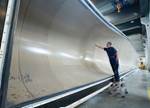Carbon fiber: Program news
In addition to the prognostications of carbon fiber industry watchers, attendees at Carbon Fiber 2010 (Dec. 7-9 in La Jolla, Calif.) also heard news of carbon fiber inroads to a number of composites programs.
In addition to the prognostications of carbon fiber industry watchers, attendees at Carbon Fiber 2010 (Dec. 7-9 in La Jolla, Calif.) also heard news of carbon fiber inroads to a number of composites programs.
Carbon fiber in pressure vessels: Jack Schimenti, president of Lincoln Composites (Lincoln, Neb.), outlined composites use in Type IV pressure vessels that feature carbon fiber as the main structural component. Although Type IV vessels are less commonly used than metallic Types I, II and III, Schimenti noted that this overall growth of the pressure vessel market for storage of compressed natural gas (CNG) in passenger and other vehicles promises a burgeoning carbon fiber market. The fastest growing Type IV market is Europe, which will consume 90 percent of these vessels by 2018. Lincoln, Schimenti reported, has increased carbon fiber use in its pressure vessels by a factor of 2.5 since 2008. A production volume of 20,000 vessels per year would consume about 300 metric tonnes (661,387 lb) of carbon fiber. Price, of course, is a factor because carbon fiber represents 40 to 60 percent of natural gas vehicle cylinder cost. Still, said Schimenti, “This will be a big business within four years.”
Press-formed thermoplastics: David Manten, CEO of Dutch Thermoplastics Components BV (DTC, Almere, The Netherlands), outlined existing and emerging opportunities for the use of press-formed carbon fiber/thermoplastic composite structures in aerospace applications, including the Boeing 787 and 747-8 and the Airbus A350 XWB, A380 and A400M. The DTC process includes infrared heating of a prepreg blank followed by compression molding and machining. Currently used primarily to fabricate clips, cleats, brackets and racks, Manten says press-formed thermoplastics are cost competitive with aluminum and titanium.
Manten noted the advantages of thermoplastics over thermosets, including better hot/wet properties, better interlaminar properties, durability, faster cycle time, long shelf life and better flame, smoke and toxicity resistance. Common thermoplastics used in aerospace applications include polyphenylene sulfide (PPS), polyetherimide (PEI), polyehtretherketone (PEEK), polyetherketoneketone (PEKK) and pulyethersulfone (PES). He said to look for skins cocured with thermoplastic stringers, carbon fiber/PEKK tape combinations, large parts up to 3m/9.8 ft long, highly loaded structural ribs, unitary parts with locally variable thickness and laser precutting of complex shapes in the near future.
Carbon fiber recycling: Jim Stike, CEO of Material Innovation Technologies (MTI, Fletcher, N.C.), reported on his company’s efforts to establish a viable carbon fiber recycling operation and declared to attendees that “we’re ready to take scrap.” MTI uses a pyrolization process to harvest carbon fiber from composite structures. The fibers can be resold as chopped reinforcement for use in thermoplastics, or MTI can use the fiber in its own process called 3-DEP. This slurry-based, net-shape forming process produces carbon fiber preforms.
MTI also is proving its ability to make finished parts from the carbon fiber it recovers. Real and potential products include door bolsters, armrests, bus panels, wheelhouse parts and a wheelchair that weighs less than 20 lb/9 kg. On the automotive front, the challenge, said Stike, is getting automakers to trial and prove parts made with MTI’s recycled carbon fiber.
Flywheels for frequency regulation: Beacon Power Corp. (Tyngsborough, Mass.) has made a name for itself with the development of flywheels for frequency regulation — a method for quickly storing and discharging electricity, particularly from alternative energy sources. Such flywheels would allow for storage of wind energy when it’s not in demand and delivery of that energy when it is in demand. Matt Polimeno, director of government programs at Beacon, reported that the company has developed its Gen 4 flywheel, a cylindrical structure that measures about 60 inches/1,524 mm tall by 36 inches/914 mm in diameter. It uses about 1,000 lb/454 kg of carbon fiber in a 7-inch/177.8-mm-thick rotating composite rim structure that uses glass fiber near its core and transitions to carbon fiber at the perimeter. Beacon makes the carbon fiber rim via a wet winding process that takes more than 24 hours to produce one rim. Polimeno said the next-generation flywheel, following the Gen 4, will use 2,400 lb/1,089 kg of carbon fiber; in addition, the company hopes to convert the flywheel’s hub from metal to a composite.
Beacon’s first frequency regulation plant, which features a series of 2-MW flywheels, is located in Stephentown, N.Y., and was tested for several months. On Jan. 24 the company announced official startup of 8 MW of flywheel energy storage at the Stephentown plant, with the full 20 MW to gradually follow.
Composites in aircraft engines: Doug Ward, consulting engineer – composites at GE Aviation (Cincinnati, Ohio), briefed the conference attendees on the extensive use of composites in the GEnx engine, developed for use on the Boeing 787 Dreamliner and the forthcoming Boeing 747-8. (Ward’s comments are the subject of "Composites enable new advances in engine technology," this issue’s “From the Podium” column, listed under "Editor's Picks," at top right.)
Controls on foreign sales: The U.S. Federal Bureau of Investigation (FBI) made a rare appearance at the conference in an effort to educate carbon fiber suppliers and users regarding control of carbon fiber technology. Anton Levey, enforcement agency, Bureau of Industry and Security at the Department of Commerce, said that for terrorists, technology is a “force multiplier,” and carbon fiber has become a highly coveted technology. Because of this, Levey cautions manufacturers to be absolutely sure of the destination and end of use of their carbon fiber and carbon fiber-based composite parts and structures. Willfully and illegally providing carbon fiber composites technology to an unauthorized customer (terrorist or criminal organization) is punishable as a criminal violation. Fines and sanctions can result even in cases that do not involve willful violation. “The lesson is this,” said Levey: “Know your customer and don’t lie to the feds. Nine times out of 10, if an agent visits your facility, it’s nothing, so don’t make it into something by lying.”
Related Content
Plant tour: Albany Engineered Composites, Rochester, N.H., U.S.
Efficient, high-quality, well-controlled composites manufacturing at volume is the mantra for this 3D weaving specialist.
Read MoreMFFD thermoplastic floor beams — OOA consolidation for next-gen TPC aerostructures
GKN Fokker and Mikrosam develop AFP for the Multifunctional Fuselage Demonstrator’s floor beams and OOA consolidation of 6-meter spars for TPC rudders, elevators and tails.
Read MoreComposite resins price change report
CW’s running summary of resin price change announcements from major material suppliers that serve the composites manufacturing industry.
Read MoreCompPair adds swift prepreg line to HealTech Standard product family
The HealTech Standard product family from CompPair has been expanded with the addition of CS02, a swift prepreg line.
Read MoreRead Next
Composites enable new advances in engine technology
CompositesWorld's conference director Scott Stephenson recalls a presentation at the recent Carbon Fiber 2010 conference (Dec. 7-9, La Jolla, Calif.) by Doug Ward of GE Aviation (Cincinnati, Ohio) on design trends in commercial jet engines that favor the use of composites.
Read MoreCarbon fiber market: Cautious optimism
As the recession recedes, the demand for carbon fiber, and the supply to meet it, will exceed prerecession expectations.
Read MoreDeveloping bonded composite repair for ships, offshore units
Bureau Veritas and industry partners issue guidelines and pave the way for certification via StrengthBond Offshore project.
Read More















.jpg;maxWidth=300;quality=90)







